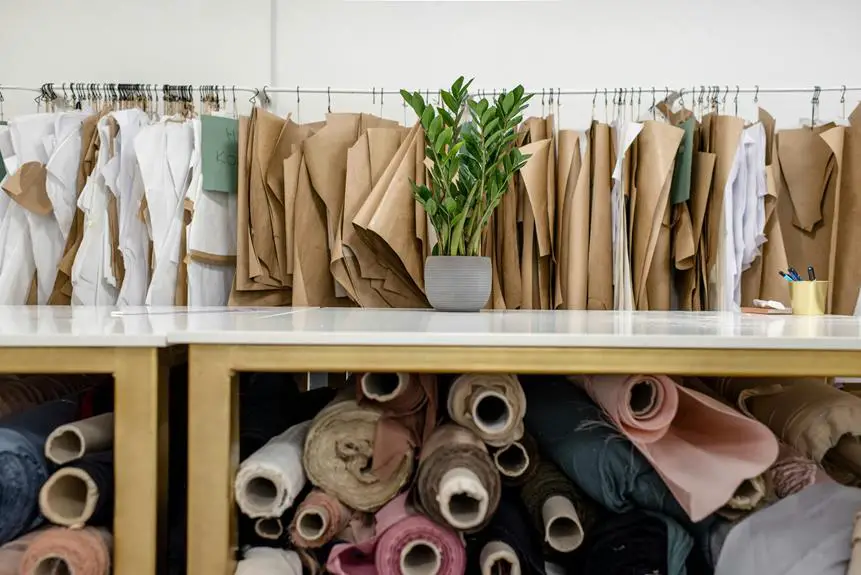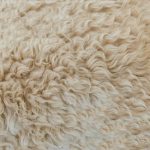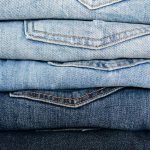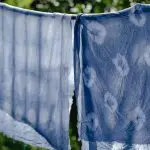When you're faced with the choice between Pinpoint and Voile fabrics, you need to consider how each option aligns with your specific needs and preferences. Pinpoint stands out for its durability and versatility, making it suitable for various occasions, while Voile offers a lightweight, airy feel that's perfect for warmer climates. But which fabric truly meets your expectations? As we explore the nuances of durability, weight, and versatility, you'll find that the better choice might not be as clear-cut as it seems.
Table of Contents
Overview of Pinpoint Fabric
Pinpoint fabric is a tightly woven cotton material known for its durability and crisp appearance, making it a popular choice for dress shirts. You'll appreciate how this fabric strikes a balance between formal and casual wear, allowing you to dress up without feeling overly stiff. The fine weave gives it a smooth finish while maintaining breathability, which is ideal for various climates.
When you touch pinpoint fabric, you'll notice its soft texture, yet it holds its shape exceptionally well. This quality makes it less prone to wrinkling compared to other cottons, so you'll spend less time ironing and more time enjoying your day.
Pinpoint's versatility shines through in its ability to be paired with both ties and blazers or worn more casually with jeans. In addition, pinpoint fabric often comes in various colors and patterns, giving you plenty of options to express your style.
Whether you're dressing for a business meeting or a casual outing, pinpoint fabric ensures you look polished and put-together. So, if you're considering your next shirt purchase, you can't go wrong with the enduring appeal of pinpoint fabric.
Overview of Voile Fabric
Voile fabric is known for its lightweight, sheer qualities, making it a popular choice for various applications.
You'll find it commonly used in curtains, summer clothing, and decorative pieces.
Understanding its composition and properties will help you see why it stands out in the world of textiles.
Fabric Composition and Properties
What makes voile fabric stand out is its lightweight, sheer quality, which lends itself well to a variety of applications. This fabric is typically made from cotton, polyester, or a blend of both, giving it a soft, breathable feel.
You'll appreciate how voile drapes beautifully, making it a popular choice for those who value elegance in their textiles.
Here are three key properties of voile fabric:
- Translucency: Voile's sheer nature allows light to filter through while maintaining a degree of privacy, ideal for curtains or overlays.
- Softness: The fabric's smooth texture feels pleasant against the skin, making it suitable for garments like blouses and dresses.
- Durability: While lightweight, voile is surprisingly strong and can withstand regular wear, making it a reliable choice for various projects.
Understanding these properties will help you make informed decisions when considering voile for your next project. With its unique characteristics, voile fabric truly shines in the world of textiles.
Common Uses and Applications
In a variety of settings, voile fabric serves multiple purposes, making it a versatile choice for both home decor and fashion. You'll often find voile used for lightweight curtains, allowing natural light to filter in while maintaining privacy. This sheer fabric adds an airy feel to any room, enhancing your decor with elegance.
In fashion, voile's breathable qualities make it perfect for summer garments like blouses, dresses, and skirts. Its soft drape creates flattering silhouettes that are comfortable for warm-weather wear. You can easily pair voile pieces with other fabrics for a stylish layered look.
Voile is also popular in crafting, especially for quilting and sewing projects. Its lightweight nature makes it easy to manipulate, allowing you to experiment with various designs. If you're a DIY enthusiast, you might enjoy using voile for decorative pillow covers or table runners, adding a touch of sophistication to your home.
Ultimately, whether you're dressing up your living space or refreshing your wardrobe, voile fabric offers a blend of beauty and functionality that suits many applications. You'll appreciate its versatility and style in every setting.
Durability Comparison
When you're comparing the durability of Pinpoint and Voile, consider how their material compositions affect their strength.
You'll want to look at how each fabric handles wear and tear over time, as well as their overall lifespan and maintenance needs.
Understanding these factors will help you choose the right option for your needs.
Material Composition Impact
The material composition of Pinpoint and Voile significantly influences their durability, affecting how well each fabric withstands wear and tear over time.
When you're choosing between these two options, it's essential to understand how their materials can impact their longevity. Here's a quick comparison:
- Pinpoint Fabric: Typically made from a blend of cotton and polyester, this fabric offers a good balance of softness and strength. The polyester adds resistance to wrinkles and fading, which means you'll likely see less wear over time.
- Voile Fabric: Usually crafted from 100% cotton, Voile provides a lightweight and airy feel. While it's beautiful and drapes well, it can be more prone to fraying and tearing compared to Pinpoint. This makes it less durable in high-use situations.
- Overall Durability: If you prioritize durability, Pinpoint might be the better choice. However, if you value a delicate appearance and don't mind a bit of extra care, Voile can still be a lovely option.
Wear and Tear
Durability plays a crucial role in how well Pinpoint and Voile fabrics stand up to everyday wear and tear.
When you choose between these two, consider how each fabric responds to your activities. Pinpoint fabric is known for its strength; it's designed to withstand rigorous use without fraying or losing its shape. So, if you're engaging in outdoor adventures or frequent wear, Pinpoint might be your best bet.
On the other hand, Voile offers a lightweight, airy feel, but it may not be as resilient against rough handling. If you're someone who prefers gentle care and isn't hard on your garments, Voile can still serve you well. However, if you frequently encounter abrasive surfaces or rough conditions, you might notice that Voile shows signs of wear sooner.
Ultimately, your choice hinges on your lifestyle. If you value durability and need something that stands the test of time, Pinpoint should be high on your list.
But if comfort and breathability are your priorities, and you handle your clothes with care, Voile can still be a suitable option.
Choose wisely based on your daily activities and fabric needs.
Lifespan and Maintenance
Understanding how long each fabric lasts and the maintenance they require can help you make a more informed choice between Pinpoint and Voile. Both fabrics have their unique characteristics in terms of durability and care, which can significantly impact your decision.
- Lifespan: Pinpoint is generally more durable, with a lifespan that can outlast Voile, especially in high-wear situations. You can expect Pinpoint to maintain its quality through multiple washes.
- Maintenance: Voile, being lighter and more delicate, requires gentler handling. It's best washed in cold water and air-dried to prevent damage, while Pinpoint can handle more robust cleaning methods without losing its shape.
- Repairability: If you ever need to mend either fabric, Pinpoint's sturdiness makes it easier to work with. Voile can be more challenging due to its fine weave, which might fray or tear more easily.
Weight and Packability
Weight and packability are crucial factors when choosing between Pinpoint and Voile, as lighter options often make your outdoor adventures more enjoyable and manageable. If you're planning a long hike or multi-day trip, every ounce counts.
Pinpoint products are designed with a keen focus on minimizing weight without sacrificing durability. This means you can carry gear that won't weigh you down, helping you conserve energy for your journey.
On the other hand, Voile offers a robust build that can sometimes translate to added weight. While their products are known for their reliability, this can be a consideration if you're looking to travel light. Voile's packability also plays a role; some of their options might take up more space in your backpack, which could limit what else you can bring along.
Ultimately, if you prioritize weight and packability, Pinpoint likely edges out Voile. You'll find their gear easier to carry and store, allowing for a more efficient packing experience.
In contrast, if you value durability over weight, Voile could still be a strong contender. Make sure to weigh your options based on your specific adventure needs.
Versatility in Use
When it comes to versatility in use, Pinpoint gear often adapts seamlessly to various outdoor activities, making it a favorite among adventurers. You'll find that this gear excels in multiple environments, whether you're hiking, skiing, or climbing.
Here are a few ways Pinpoint gear stands out:
- Multi-Activity Compatibility: You can easily switch from one activity to another without needing to change your gear. Pinpoint gear is designed for flexibility, allowing you to tackle different terrains with confidence.
- Adjustable Features: Many Pinpoint products come with adjustable straps and customizable settings. This adaptability means that you can modify your gear based on the specific requirements of your adventure, enhancing your experience.
- Weather Resistance: Pinpoint gear often incorporates materials that resist various weather conditions. Whether it's unexpected rain or harsh winds, you can count on your gear to keep you protected and comfortable.
With these features, you won't just be limited to one type of adventure. Pinpoint gear truly empowers you to explore the outdoors in diverse ways, making each outing an exciting new experience.
Cost Analysis
Evaluating the cost of Pinpoint and Voile gear reveals significant differences that can impact your budget and overall adventure experience.
When you compare the price tags, you'll notice that Pinpoint products tend to be priced higher than Voile's offerings. This can be attributed to the brand's focus on premium materials and advanced technology, which may appeal to those seeking top-tier performance.
However, Voile gear often provides excellent value without sacrificing quality. If you're on a tighter budget, Voile's options might be more attractive, allowing you to allocate funds to other essential gear or experiences during your adventure.
You should also consider the longevity of the products; investing more upfront in Pinpoint gear could save you money in the long run if it lasts significantly longer.
Additionally, keep an eye out for sales or discounts, as both brands occasionally offer promotions that can make their products more accessible.
Ultimately, your decision should weigh the initial investment against the potential benefits you'll gain in terms of performance and durability. Balancing your budget with your adventure goals will help you make the best choice for your needs.
Final Recommendations
For the best experience, consider your specific needs and preferences before choosing between Pinpoint and Voile gear. Both brands offer outstanding products, but they cater to different types of adventurers. Here are some recommendations to help you decide:
- Evaluate Your Activities: If you're into backcountry skiing or snowboarding, Voile's lightweight and durable gear might be more suitable. Pinpoint, on the other hand, excels in versatility, making it great for various outdoor activities.
- Assess Your Budget: Pinpoint gear often comes at a higher price point, but it may provide features that justify the cost. If you're on a tighter budget, Voile offers solid options without sacrificing quality.
- Consider Your Skill Level: Beginners might find Pinpoint's user-friendly designs easier to handle, while experienced users may appreciate the advanced features Voile provides.
Ultimately, your choice should align with how and where you plan to use the gear. Take the time to reflect on these factors, and you'll find the perfect fit for your outdoor adventures.
Frequently Asked Questions
What Are the Environmental Impacts of Pinpoint and Voile Fabrics?
When considering the environmental impacts of fabrics like pinpoint and voile, you'll find that manufacturing processes, resource usage, and biodegradability vary significantly. Each fabric type has unique effects on ecosystems and sustainability that you should assess carefully.
Can Pinpoint and Voile Fabrics Be Easily Recycled?
You'll find that pinpoint and voile fabrics aren't typically easy to recycle. Their synthetic fibers often complicate the recycling process, making it challenging to repurpose. It's best to check local facilities for specific recycling options.
How Do Pinpoint and Voile Fabrics React to UV Exposure?
When exposed to UV light, pinpoint fabrics tend to fade more quickly than voile. However, voile's lightweight nature may make it more susceptible to damage, so you should consider both factors for your specific needs.
Are There Any Common Blend Fabrics That Include Pinpoint or Voile?
Yes, you'll find several common blend fabrics that include pinpoint and voile. Often, they're blended with cotton or polyester, enhancing durability and breathability while maintaining a soft feel and elegant drape for various applications.
Which Fabric Is More Suitable for Sensitive Skin?
If you've got sensitive skin, you'll want a fabric that's soft and breathable. Look for natural fibers like cotton or linen, as they're less likely to irritate your skin compared to synthetic materials.
- How Does Ring Spun Cotton Affect Garment Fit and Shape Retention? - August 13, 2024
- What Are the Challenges in Producing Ring Spun Cotton? - August 13, 2024
- Is Ring Spun Cotton Suitable for Plus-Size Clothing? - August 13, 2024







